I’ll admit, I messed up a bit on this particular walk. For much of the tour, I had the camera at the wrong setting and many of the photos are too bright. To compound matters, I had a smudge on the lens (despite my habit of snapping on the lens cover between shots) and there’s a noticeable blur on some of the pictures.
Other than that, though, this was a momentous day I had waited over 15 years for, as The High Bridge over the Harlem River was opened to the public for the first time in over 40 years at least. I wasn’t there for the ribbon cutting, but I waited for sunnier weather a few days later. As you will see, the sun was out for my trip across the bridge and the clouds filled in pretty quickly once I got to the Bronx, but it didn’t matter: I got the pictures I wanted.
GOOGLE MAP: WASHINGTON HEIGHTS TO YANKEE STADIUM VIA THE HIGH BRIDGE
When I left off I had just completed my first-ever walk across The High Bridge and I was now in the Bronx neighborhood unsurprisingly called High Bridge, a hilly football-shaped area defined by the Harlem river, Jerome Avenue (which curves to form the east and south border), and the Cross-Bronx Expressway. In the past I had used the name Highbridge Heights, but was met with some indignancy from folks who prefer Highbridge.
I proceeded along some routes I lad left unexplored in the past, and it’s getting a little frustrating since at age 57, I have just a prime few years of walking remaining. I have come to the realization that, try as I may, I’ll never walk (or even bicycle) every inch of every street in NYC. The only thing to do is do as much as possible…

The east end of The High Bridge leaves you at University Avenue and West 170th Street. University Avenue, named for the New York University campus now occupied by Bronx Community College (the Hall of Fame for Great Americans is on the campus) has three disparate sections: a quiet two-lane road from its southern end at Sedgwick Avenue north to the Cross-Bronx Expressway, then it’s a multi-lane behemoth north to Kingsbridge Road, then a few more blocks of quiet before it peters out at the Jerome Park Reservoir.
Along much of its length it has been sub-named Martin Luther King, Jr. Boulevard since 1988, for the assassinated civil rights leader.
The stretch of University Avenue that The High Bridge lets out on was named Lind Avenue in its early years, possibly for singer Jenny Lind, the “Swedish Nightingale.” And, the northern end of the avenue was earlier Aqueduct Avenue, for the Croton Aqueduct.
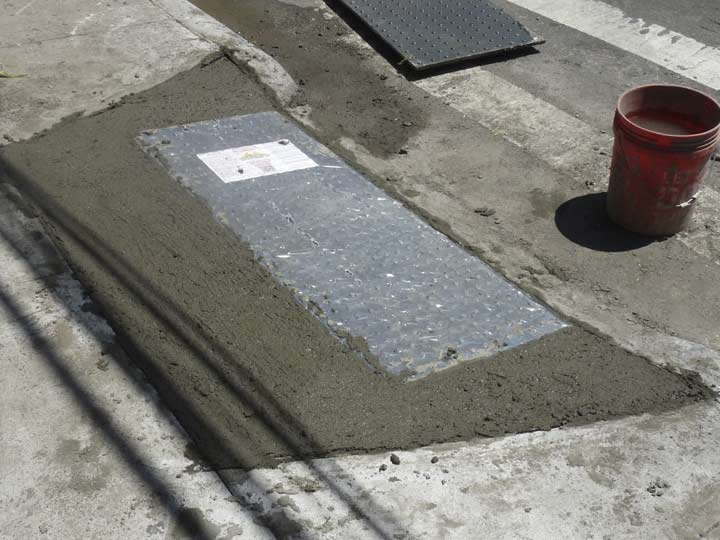
Plans call for The High Bridge Bronx landing to be upgraded and repaired. New crosswalks were already being installed on University Avenue the day I was here.
West 171st Street is one of many “step streets” built to get pedestrians up and down steep hills. In NYC most of them are in the Bronx and upper Manhattan, though you can find a few in Queens and Brooklyn, which are less hilly.
Such step streets sometimes preserve ancient streetlamp models, though this one has a design generally found on them.
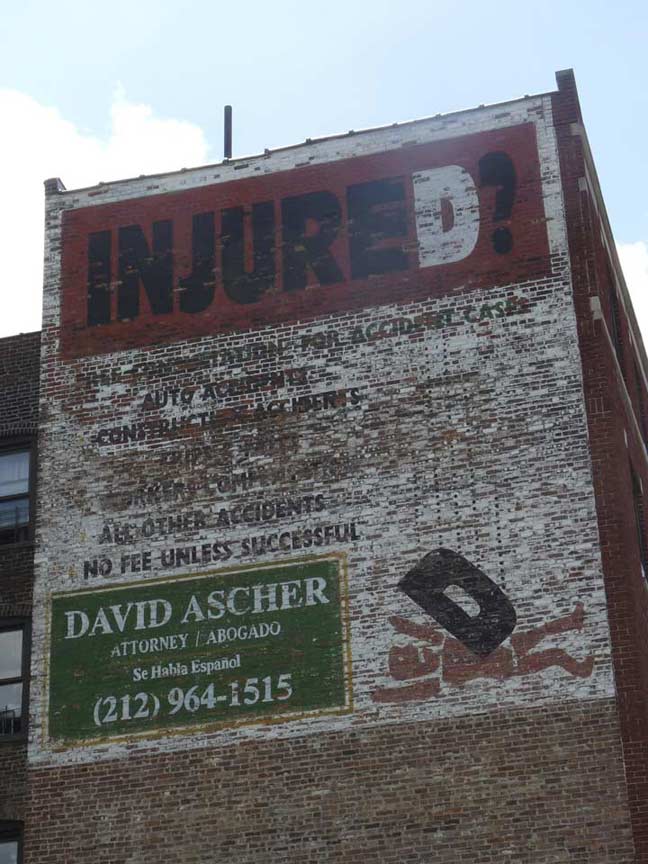
Somewhat faded ad for slip and fall lawyer on Merriam Avenue where it meets University Avenue. It’s likely 25 to 30 years old. I found a much older example later on in my walk.
Unfortunately, Merriam Avenue has nothing to do with the Merriam brothers, George and Charles, who purchased the rights to An American Dictionary of the English Language after its author Noah Webster’s death. The street is named instead for a long-ago landowner.
Also disappointingly, the Bronx’ lengthy Webster Avenue is named neither for Noah nor for famed Massachusetts Senator and later Secretary of State Daniel Webster. According to Bronx historian the late John McNamara, Webster Avenue is probably named for an engineer or a surveyor in the NYC Department of Public Works in the 1870s, when the avenue was named. (Bear in mind that the Bronx west of the Bronx River was part of New York County, which also included Manhattan, until the whole county got its “independence” in 1914.)
Daniel Webster’s fans, though, can content themselves with his massive statue in Central Park.

At Washington Bridge (not the George Washington Bridge; see explanation in Part 1, linked above) University Avenue gains some lanes as it assumes the path of Edward L. Grant Highway. From my FNY page about NYC streets that bear the full names of people:
It’s one of the few streets in NYC designated “Highway” (Kings Highway is the longest and most famous). Formerly Boscobel Avenue, it was renamed in 1945 for a baseball player, but not a New York Yankee…Edward Leslie “Harvard Eddie” Grant played in the major leagues between 1905 and 1915 for the Phils, Reds and New York Giants, hardly a superstar but a workaday infielder. He was killed at Argonnes, France in October 1918, 3 years after his baseball career ended. Grant was the first major leaguer or ex-major leaguer to be killed in WWI action. In 1921, the Giants dedicated a plaque in the centerfield at the Polo Grounds in his memory; the plaque is duplicated at the Giants’ present home, AT&T Park in San Francisco.
Grant Highway runs northwest from Jerome Avenue and West 167th Street to University Avenue (Martin Luther King Boulevard) where it meets Washington Bridge.

Featherbed Lane Presbyterian Church at University Avenue. The Ionic-columned, classically styled church was built from 1927-1928 and designed by architect Gamble Rogers. It still contains its original Möller organ.
New York City has weeded out most of its more colorful names over the decades, such as the Bronx’ Bear Swamp Road, Staten Island’s Skunks Misery and Gun Factory Roads and Queens’ Black Stump Road and Quarrelsome Lane, so I’m glad the Bronx still has Featherbed Lane, which runs in two pieces from Jerome Avenue west to Macomb’s Road and from Macomb’s Road and Grand Avenue west to University Avenue. It runs where West 173rd Street would normally be.
Oddly the name does not seem to be a colonial-era relic since it begins appearing on maps as late as 1890. John McNamara has floated several ideas about how the road got its name, such as Loyalists laying featherbeds on local lanes to muffle the British army’s hoofbeats; farmers upholstering their wagons with featherbeds on the rutted roads; or, during the construction of the Croton Aqueduct in the 1840s, prostitutes had a bangup business from the local workers, on, you guessed it, featherbeds. The name was likely used informally for several decades and when the streets were laid out and built, Featherbed Lane was included.
A NYS historical marker was once located at the traffic triangle at Featherbed Lane and University Avenue. The plaque explained the origin of this unusually-named street: So called from story that farmers’ wives, in 1776, aided Americans to escape British by spreading featherbeds on the lane.

Here’s a huge painted ad for the former Economy Drugs on Featherbed Lane and Jesup Avenue in the Bronx’ High Bridge section. There’s still a drugstore across the street, but it’s now a Rite Aid.
Look carefully and you will see the outline of the “vessel with the pestle” motif that many older drugstore ads use. The TR exchange in the Bronx stood for TRemont (in Manhattan it was Trafalgar and in Brooklyn it was TRiangle).
Note also that the “wall dog” had to improvise to fit the long word “prescriptions” into the space.
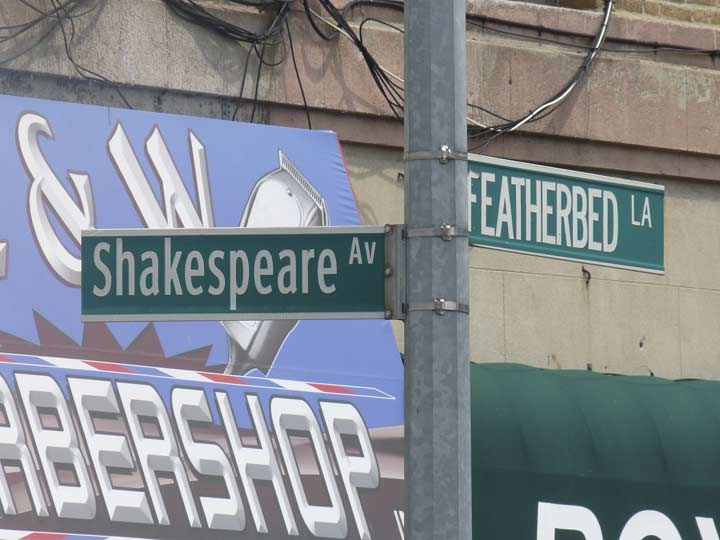
The Highbridge neighborhood was in large part once the Marcher estate. The lord and lady of the property maintained a formal garden dedicated to the works of William Shakespeare and displayed busts of the Bard himself and some of his best-known characters. The heavy hand of modernity eventually encroached, and the property was sold off. Only Shakespeare Avenue is a current reminder of the Marcher estate and its garden.
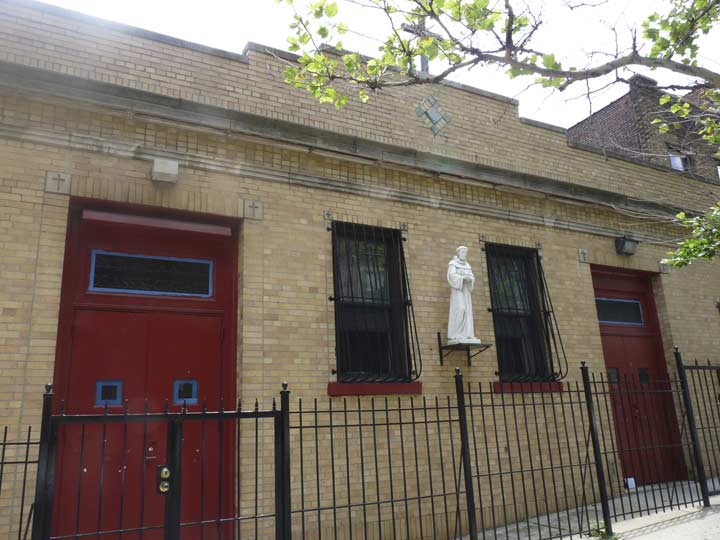
One of the humblest Catholic churches you’ll see in NYC, where most Catholic parishes built the equivalents of small towns with their own separate economies, can be found on Shakespeare Avenue south of Featherbed Lane, St, Francis of Assisi, established in 1928 in what was then a primarily Jewish neighborhood; the church could not afford a school, rectory, convent, etc. The parish has since become part of the larger Sacred Heart parish further south on Shakespeare Avenue.

The west-facing side of the same building with the Economy Drugs sign has an even more faded example of the genre, for Royal Cleaners. Everything but the name has been pretty much erased.
I often call the Bronx the Borough of Apartment Buildings, but there is an additional element that sets the Bronx’ apartment buildings apart from other boroughs. The Bronx is not a strict grid due to uneven topography and streets often intersect at angles. Sharp angles often create roughly triangular plots, but there are often obtuse angles, and on those, Bronx apartment houses were constructed with sweeping curves. Nowhere else in any other borough are such curves featured on these buildings to the degree found in the Bronx.

There has been a stuffed bear mascotting an auto glass/iron works shop at Macombs Road and Featherbed Lane as long as I have been exploring this area on occasion, which goes back over a dozen years. I couldn’t get a better shot because the bear is behind a couple of signs and I didn’t feel like crossing Macombs Road, which is a bit fast and furious.

Just to give you an idea of how clogged the Cross Bronx Expressway gets around midday, seen from Macombs Road. The expressway connects the George Washington Bridge with the Throgs Neck Bridge into Long Island, and was gouged out of several disparate neighborhoods by NYC traffic czar Robert Moses from the mid-1950s into the early 1960s.
When I see scenes like this, I’m glad I don’t drive. On bucolic country roads, I wish I did.
“If you have ever wondered if you’re in Hell, then you are experiencing a rather normal spiritual quandary that you share with many. If however, you know without the shadow of a doubt that you are in Hell, then you must be on the Cross Bronx Expressway!” –– former NYC lamppost king Jeff Saltzman, who moved to North Carolina a decade ago
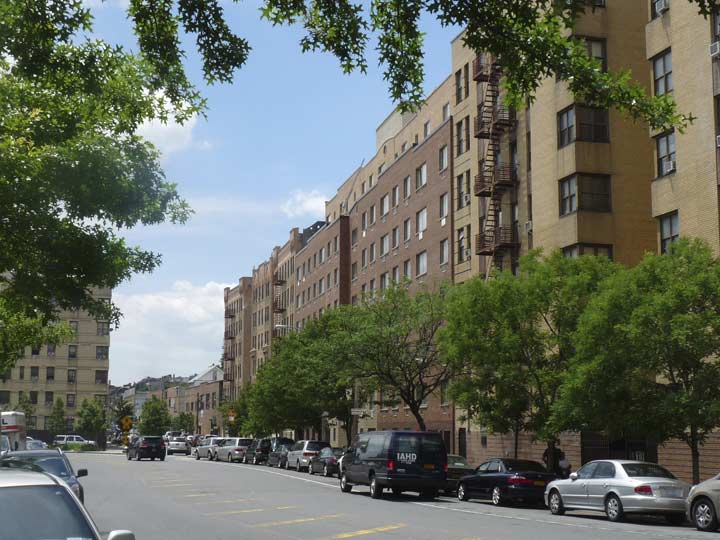
Macombs Road, which like Featherbed Lane runs between Jerome Avenue and University Avenue but at a much steeper angle, is named for Scottish immigrant Robert Macomb, who built the second bridge across the Harlem River; the Kings’ Bridge (between today’s Inwood and Marble Hill) was the first. After being granted permission in 1814 from the city to build the bridge, Macomb dammed the river at where West 160th would be. Angry area farmers tore down the dam in 1836, reopening the river to boat traffic. A wooden swing drawbridge replaced the dam, and the current steel bridge designed by Alfred Pancoast Boller replaced that bridge in 1898.

I was fascinated by the sight of the small white house wedged between two warehouses on Cromwell Avenue as seen from Macombs Road and Inwood Avenue.
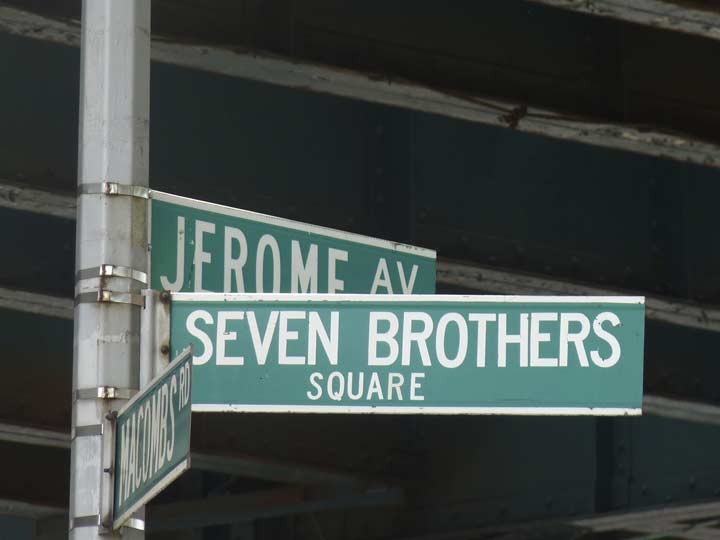

Seven Brothers Square, at Jerome Avenue and Macombs Road, was not named for the 1950s movie musical, but for the Bronx-based Santini Brothers Moving Co., which began as the Seven Brothers Movers, founded in 1905, the subjects of a History Channel series in 2013.
The intersection is marked by the oblong Keltch Park, bordered by the two-block long Plaza Drive. The park remembers local seaman Ruben Keltch, killed in an attack by a German U-boat in the Atlantic Ocean in 1943.
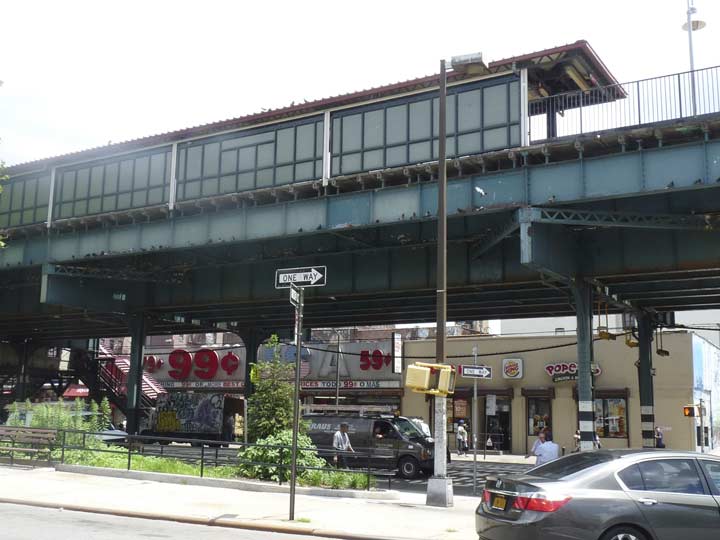
The 170th Street station serving the #4 train over Jerome Avenue and one of the few “shoebox” lamps along the stretch of Jerome north of Yankee Stadium.
Showing some of the interesting signage on Jerome Avenue businesses between West 169th and 170th Streets along Jerome Avenue, named for 19th Century financier and racetrack owner Leonard Jerome, the grandfather of Winston Churchill.
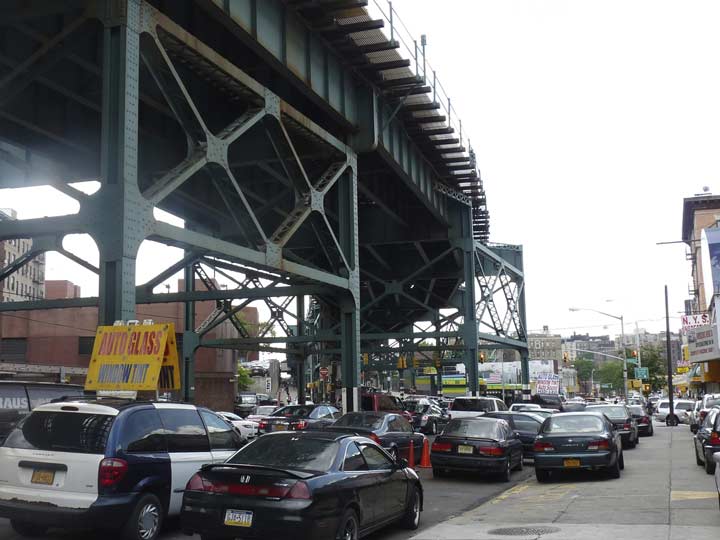
Walking south, the elevated curves onto River Avenue, exposing Jerome Avenue for about a mile before it empties into the Macombs Dam Bridge. This is the only sunlight Jerome Avenue sees except for a couple of blocks in Bedford Park and a strecth adjoining Woodlawn Cemetery.

I have found that the Bronx has more surviving “arrowhead” signs than any other borough. The signs are color coded, white/red for the Throgs Neck, blue/red for the Whitestone. The signs are pointing to the Cross Bronx Expressway, which connects to both.
I stuck with River Avenue under the el. The street name doesn’t refer to the Harlem, Bronx or Hudson Rivers, but a now-vanished waterway called Cromwell’s Creek, which ran through what was a swampy region in the colonial era.
You never know what you’ll find under els, and here you will find a concentrated number of curved-mast octagonal-pole lamps, which were placed here in the early 1950s and haven’t been produced since then. They are increasingly rare around town.
I was fascinated by this Italianate building at 1223 River Avenue, north of West 167th. I’m stumped on how this diminutive gem has survived over the years, and there’s no Daytonian in Manhattan to provide information on it — it’s not in Manhattan! There is a crest of some kind over the front door, so if anyone can identify it, let me know.
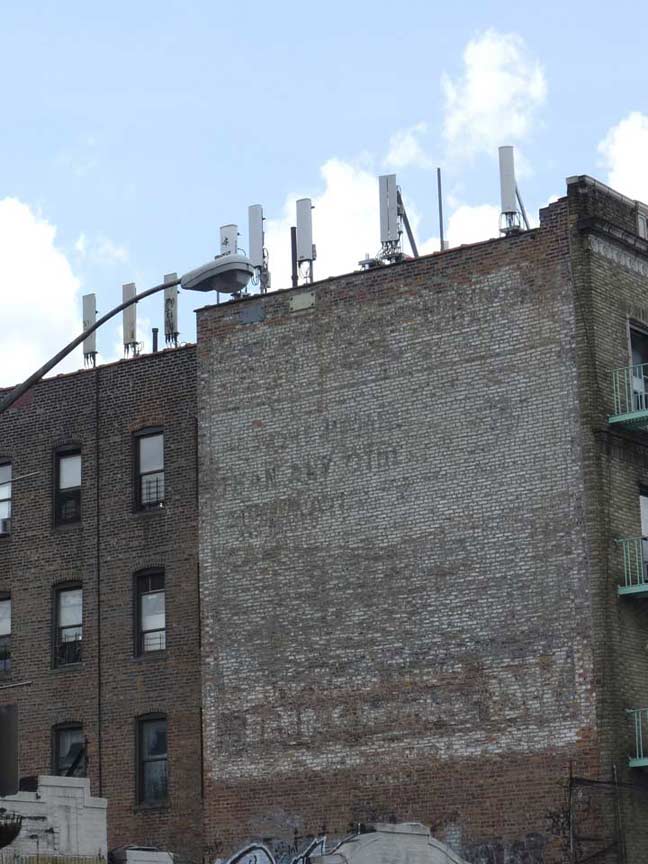
An extremely faded ad on West 167th near River Avenue. About all I can recognize in the lower right corner is script for All Detergent.
John Mullaly Park, which at present runs from East 164th north to just past East 166th between Jerome and River Avenues, was truncated at its southern end to make way for the New Yankee Stadium.
This park honors John Mullaly (1835-1911), a newspaperman and civic official who was a tireless proponent of green space and the father of the Bronx parks system. Born in Belfast, Ireland, Mullaly came to the United States as a young man and soon became a special correspondent for the New York Herald. He reported on the laying of the first Transatlantic Cable (1857-58), and served as secretary to the inventor Samuel F. B. Morse. As editor of the Metropolitan Record, then the official publication of the Roman Catholic Church in New York City, Mullaly developed a printing technique known as aluminography. He also worked at the New York Tribune and the New York Evening Post. Later he served as New York Commissioner of Health and as a two-term member of the board of tax assessors. NYC Parks
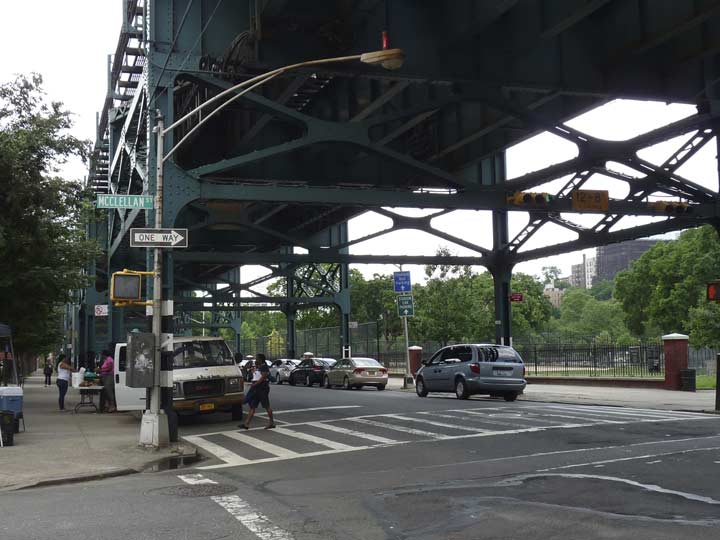
At River and McClellan Street is a true rarity, a dwarf double-mast post. I’d say less than a dozen of these can be found around town. This one also held a fire alarm lamp.
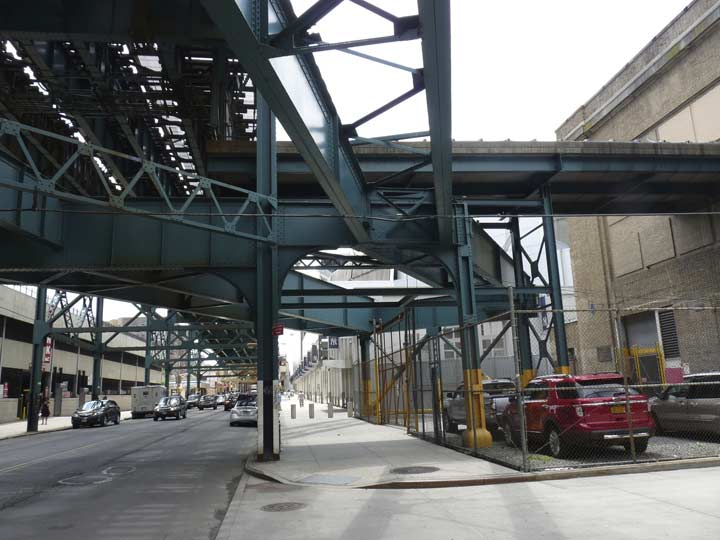
Skipping south a couple of blocks, we see an el superstructure pointing west between the New Yankee Stadium and a parking garage. This is the only extant remnant of the Ninth Avenue El, which until the 1950s was carried over the Harlem River on a bridge, then went into a tunnel under the cliffs and emerged on another trestle at Jerome and Anderson Avenues.
From 2007-2009, construction of the New Yankee Stadium eliminated West 162nd Street, but managed to spare the old el cutoff.
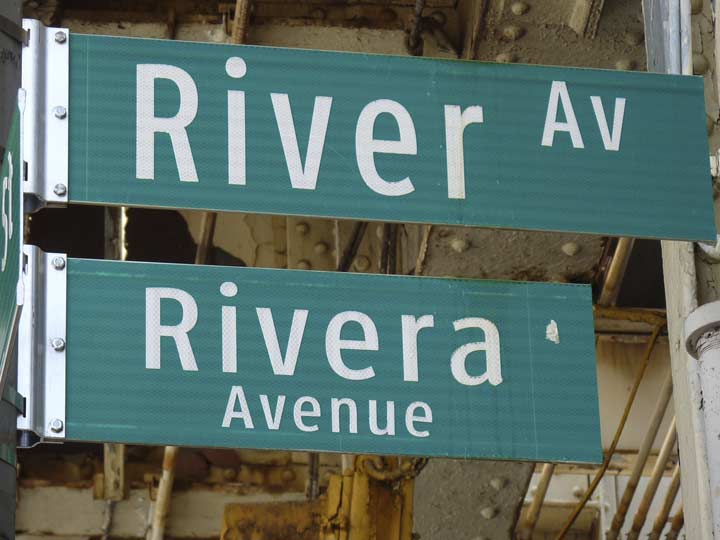
When the Department of Transportation subnamed the block of River Avenue in front of Yankee Stadium for longtime ace reliever Mariano Rivera, who played for the Yankees between 1995 and 2013, only a letter needed to be added to the name on the extra sign.
It took about two years to completely tear down the old Yankee Stadium, which was built at River Avenue and West 161st Street in time for the 1923 season, the Yankees’ fourth with Babe Ruth; that year, they won the first of their 27 World Series. Finally, Macombs Dam Park and Heritage Field took the old Stadium’s place. Included was a section of the Yankee Stadium facade; when the Stadium was refurbished during the 1974 and 1975 seasons, most of the old facade, which stretched about three-quarters around the park, was torn down and only two short sections, or new short sections, replaced it.

The New Yankee Stadium opened with a loss to the Cleveland Indians in April 2009; indeed, the Indians walloped the Yankees with a 22-run onslaught the same week. However, just like in 1923 the Yankees inaugurated their new stadium with a World Series victory later that year, just in time for longtime owner George Steinbrenner to see one more championship.
Oddly I have not seen a game yet at the new park, though I have toured the clubhouse and sat in the dugout! At the old Stadium I saw a no-hitter by Jim Abbott, who was born with one hand, in 1993 and in 2008 I saw Mike Mussina win #19 in what would be a 20-win season, the last season in his career.
A short street on the west side of the old Stadium, Ruppert Place, has been replaced by a walkway called Ruppert Plaza, with flagstones commemorating Yankee Stadium highlights. In addition to 26 World Series championships, the old Stadium was the home of the football New York Giants; heavyweight boxing; religious conventions and rock concerts.
Brewery magnate Colonel Jacob Ruppert (1867-1939) purchased the Yanks in 1914 with partner Tillinghast Huston, a successful engineer. Ruppert bought him out three years later and became sole owner. Ruppert oversaw the beginnings of a five-decade Yankee “dynasty” that saw them win more World Series titles by far than any other major league team. A street on the western edge of Yankee Stadium between East 157th and 161st Streets, Doughty Street, was renamed for Ruppert in 1933. Doughty Street has a lengthy lineage, overlaying Cromwell’s Creek, or Doughty Brook. The Dutch called the now-underground rivulet Maenappis Kill, and the Indians called it Mentipathe.
With that, it was time to kick it in the head for this walk, which saw what will likely be a number of crossings over The High Bridge for me.
7/20/15


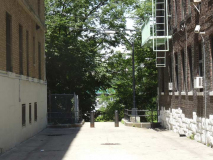
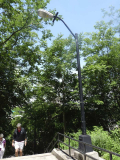

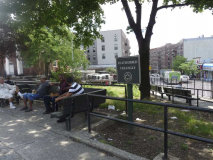
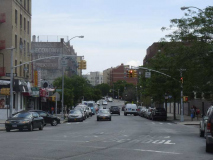
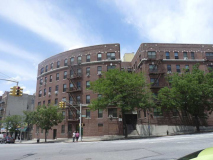
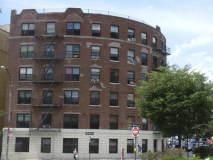
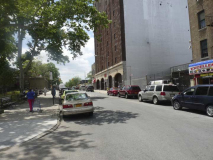
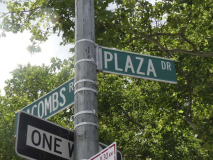
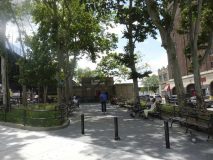
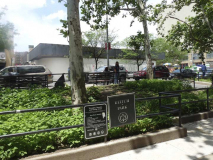
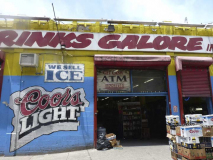
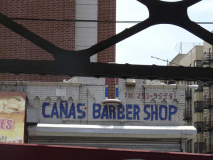

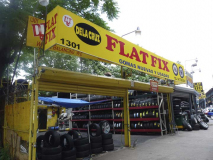

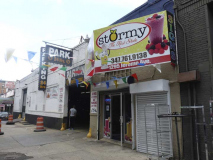
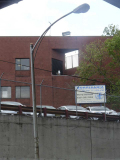
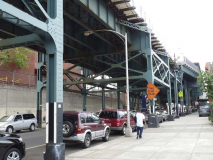
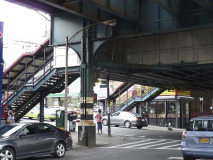
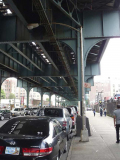
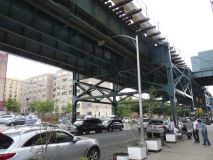
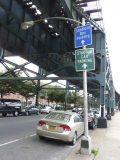
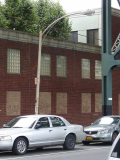
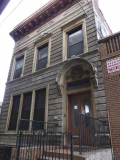
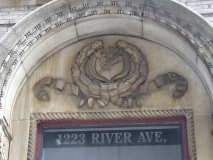
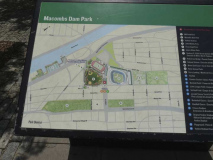
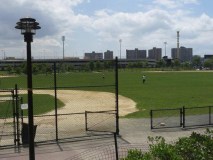

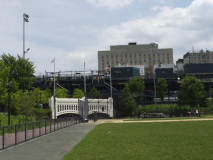
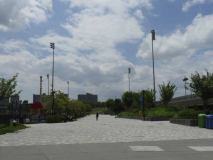
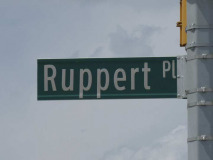
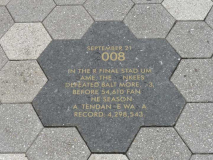
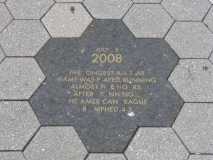

15 comments
This website has what appears to be a a photo taken soon after the home’s 1905 date. http://www.ouroldneighborhood.com/Images2/1223RiverAvenue1917.jpg
The figure over the door looks like a Scottish thistle, not a crest.
The Cromwells after whom Cromwell Avenue and Cromwell Creek are named were early settlers in the Bronx and related to Oliver Cromwell, a non-monarch who briefly ruled England in the 1600s.
I’m glad that I wasn’t the only viewer of History Channel’s “7 Brothers” series. You have to give History Channel credit for a wide variety of topics. From extreme rural (“Swamp People”, “Mountain Men”) to extreme urban (“7 Brothers”) & everything in between (“Down East Dickering”), it’s so nice to see programming that celebrates the spirit of independence.
At least now I know why The Bronx has Shakespeare Avenue after years of figuring why it’s there.
This walk sets off stories and memories for me.
First, on Eddie Grant — his plaque was indeed in the Polo Grounds and here are some links to the fate of the plaque. It was prised out of its hole by a New York Police Officer and hidden in the cop’s home in Ho-Ho-Kus, New Jersey, where it was discovered in 1999.
There are now three of them: the original, at the Baseball Reliquary in Los Angeles, a replica at Citi Field in New York, and another replica in San Francisco’s Pac Bell (AT&T Park), put there after the 2002 World Series, which is believed to have ended a curse slapped on the team when they moved to San Francisco without taking the plaque — they did not win a World Series before doing so, and have not lost one since.
Featherbed Lane was reportedly a retreat route for Continental artillery (commanded by Colonel Knox) from the British, and the featherbeds were scattered to silence the sound of their horses’ hooves and the wheels of their gun limbers.
My father remembered riding the 9th Avenue elevated and the Anderson Avenue shuttle more than a few times — the bizarre partially underground elevated line. Only in New York.
I was present for the last day game at the old Yankee Stadium, won by Robinson Cano. I also sat through all 14 innings of that All-Star game in 2008, meticulously keeping score, and taking home six of the souvenir seat cushions provided fans. I actually took out 10 after the game (some folks were hauling off shopping bags full of the abandoned covers), but gave four of them to weary-looking Transit workers on the 161st Street Station platform, who were sorting out subway trains and passengers at 3 a.m. They looked like they needed them and certainly deserved them. They were delighted.
I was there for the first day game at the new Yankee Stadium, in 2009, an exhibition with the Chicago Cubs, watching AJ Burnett and Andy Pettite split the pitching duties in the win.
A week later, I took my daughter to the aforementioned 22-4 disaster, in which the Cleveland Indians ruthlessly stomped Chien Ming-Wang and Anthony Claggett in his major league debut. My daughter was not impressed. I apologized for the farcical game, and asked if she wanted to see another one. “Only if you can guarantee it won’t turn out as badly as this one,” she said.
“I think I can guarantee that,” I said. We went again, the Yankees won, but my daughter lost interest in baseball after that…she regards all ball games as “sportsball.”
In the southeast corner of the old Yankee Stadium site are binocular-like devices. Peer into them and you can see scenes from the old Yankee Stadium’s history.
Also, take a look again at the Throgs’ Neck and Bronx-Whitestone signs, and note the code-within-the-code…the signs for the bridges that span the East River from Queens to The Bronx have little tags on top, to indicate where they are. The two bridges to Rockaway have what look like life preservers around their triangles. The Triborough Bridge Authority had some creativity with its markers.
I’m surprised your route through High Bridge neighborhood didn’t include Ogden Ave. Ogden is the main commercial street in the neighborhood and a former trolley route (& now 2 bus routes). But unlike most commercial streets in the Bronx, Ogden is very narrow & twisty. As such, as most of the neighborhood, providing a village feel.
Ogden is on another FNY page — do a search for Ogden
The street naming for Mariano Rivera was actually passed into law by the City Council and then signed by then Mayor Bloomberg. The Department of Transportation doesn’t name streets, it just puts up the signs.
As a Bronx youth several millennia ago, I hated the Yankees but loved the Giants, at least until the latter betrayed New York. I’m profoundly gratified to see that some fragment of my old Ninth Avenue El Polo Ground “Shuttle” still lives on, however abbreviated it is.
During the Great Depression, my Pop would sometimes take the family for an “outing” on the 9th Avenue El from Fordham Road and Jerome Avenue to South Ferry, and then on the 3rd Avenue El from South Ferry to Fordham Road and Webster Avenue — or vice-versa. When fares were a nickel, that was a cheap treat!
Now that sounds like a lot of fun !
https://youtu.be/HG5YEj9oHl8 is a slideshow of all flagstone memorials on Rupert Plaza.
https://youtu.be/fg8OKE4UXVk shows the final resting place of namesake Jacob Ruppert among others.
Thanks Kevin
I have never visited New York, but feel I know the city through your wonderful website. My home city of Liverpool (U.K.) also had an ‘el’, the Liverpool Overhead Railway which ran from 1893 until 1956. The southern terminus and first section of route were in a tunnel with the line emerging onto the elevated structure when it reached the docks on the River Mersey. The tunnel portal in the rock face at Dingle is one of the few surviving on-site relics of the railway. I was born in 1955, and when the closure of the line was announced my father took me for a ride on it. Unfortunately, I was too young to remember the experience but at least I can say I rode on the ‘Dockers’ Umbrella’!
That’s my grandma’s house on 1223 River Ave.